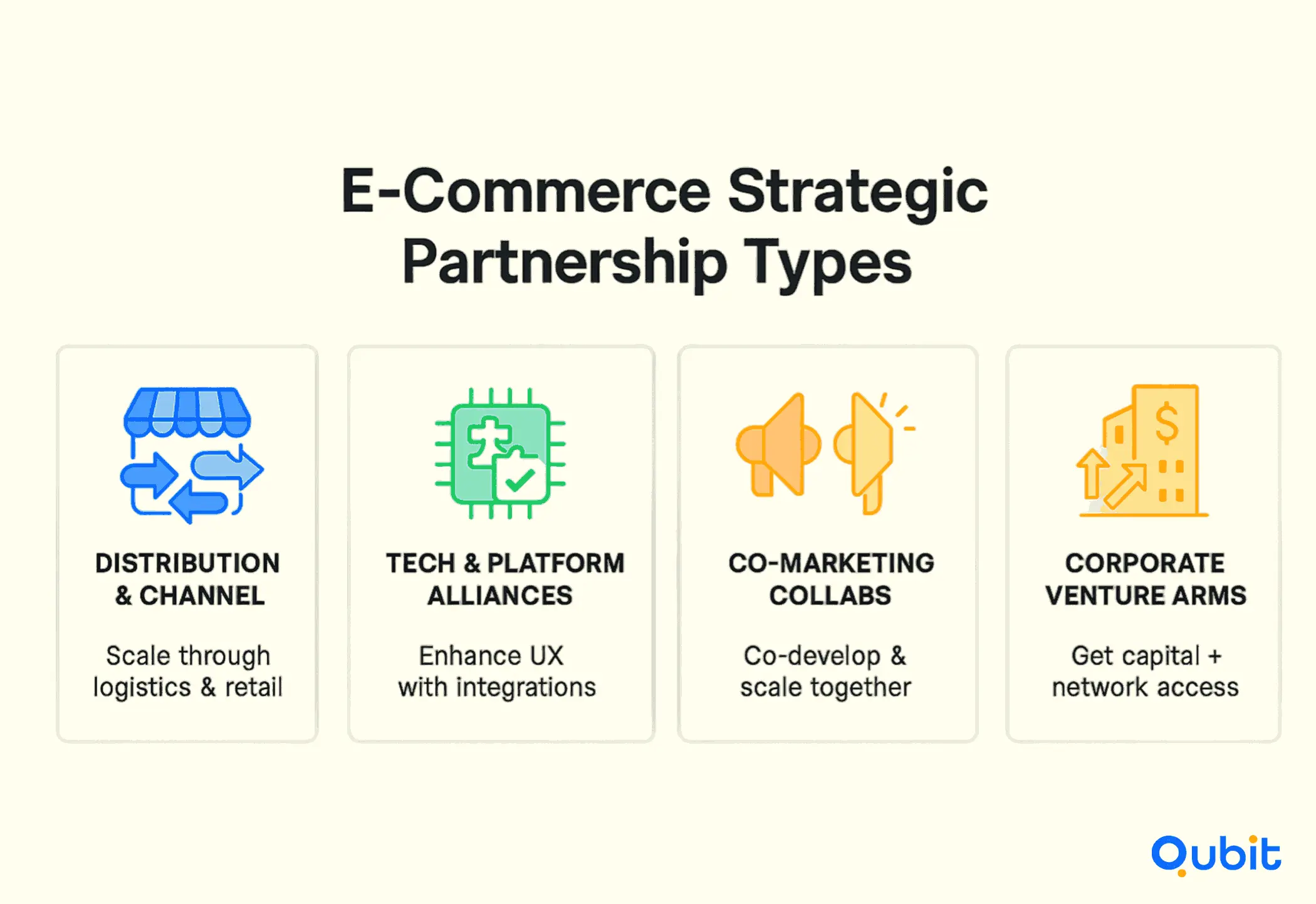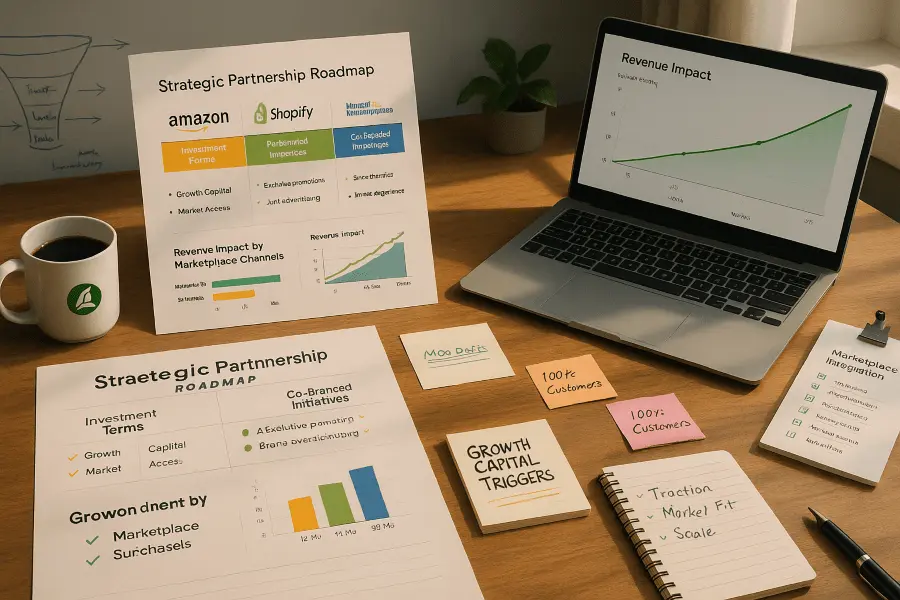Strategic partnerships and marketplaces are transforming how businesses access growth capital. By collaborating with key players and tapping into expansive platforms, brands can unlock new revenue streams and scale faster. For instance, the Asia Pacific e-commerce market is projected to reach US$4.2 trillion by 2024, with an anticipated 10% CAGR through 2029, highlighting immense opportunities for businesses that embrace international partnerships.
Moreover, the growing demand for frictionless omnichannel experiences underscores the importance of integrated strategies. Partnerships that align operational efficiency with consumer expectations can position brands for long-term success. To explore how these strategies fit into broader funding approaches, check out ecommerce startup fundraising strategies, which provides a detailed perspective on securing capital for e-commerce ventures.
Strategic collaboration is no longer optional—it’s essential for unlocking growth capital.
The Power of Strategic Partnerships in E-Commerce
Strategic partnerships are alliances formed between your startup and other organizations—be they established companies, complementary brands, technology providers, or logistics firms. These collaborations are not just about mutual benefit; they are a strategic maneuver to access new resources, markets, and expertise, ultimately driving innovation and resilience.
Key Benefits of Strategic Partnerships
- Resource Efficiency and Cost Savings: Partnerships provide access to essential tools, infrastructure, and expertise without significant upfront investment. For example, teaming up with a logistics company can streamline your supply chain, while a tech partnership can enhance your platform’s capabilities.
- Market Expansion: By leveraging a partner’s existing customer base and distribution channels, startups can enter new markets much faster than going it alone.
- Brand Awareness and Trust: Associating with reputable partners enhances your own brand’s credibility and visibility.
- Risk Mitigation: Sharing operational and financial risks with partners makes your business more resilient, especially when entering new markets or launching new products.
- Knowledge and Expertise: Access to industry insights, best practices, and mentorship from experienced partners can be invaluable for navigating challenges and scaling efficiently.
Types of Strategic Partnerships for E-Commerce Startups

- Distribution and Channel Partnerships: Collaborate with established retailers, logistics providers, or global marketplaces to reach broader audiences and streamline fulfillment.
- Technology and Platform Alliances: Partner with SaaS providers, payment gateways, or marketing platforms to enhance your store’s capabilities and reduce development costs.
- Co-Marketing and Brand Collaborations: Launch joint campaigns, product bundles, or influencer partnerships to amplify reach and drive customer acquisition.
- Joint Ventures and Licensing: Share resources and risks to enter new markets or develop new products, demonstrating operational maturity to potential investors.
- Corporate Venture Partnerships: Work with corporate venture arms for both capital and access to extensive networks, technology, and distribution.
Growth Capital Through Marketplaces
Marketplaces such as Amazon, Shopify, and Walmart Marketplace offer e-commerce startups instant access to millions of potential customers, built-in trust, and streamlined logistics. Listing your products on these platforms can:
- Validate Demand: Marketplace traction provides tangible evidence of product-market fit and operational readiness—metrics that investors value highly.
- Generate Key Metrics: Data on GMV (Gross Merchandise Value), repeat purchase rates, and customer reviews help demonstrate traction and scalability.
- Accelerate Cash Flow: Marketplaces can drive sales volume and improve cash flow, making your business more attractive to both lenders and investors.
How Partnerships and Marketplaces Attract Growth Capital
1. Demonstrating Traction and Validation
Investors want to see proof that your business can scale. Strategic partnerships and marketplace success provide hard evidence of demand, operational capability, and brand appeal.
2. Enhancing Financial Readiness
Collaborations can improve margins, reduce customer acquisition costs, and boost operational efficiency. For example, a partnership with a fulfillment provider can lower shipping costs and improve delivery speed, directly impacting profitability and investor confidence.
3. Reducing Risk and Increasing Resilience
A diversified network of partners and channels makes your business less vulnerable to disruptions, which is a key consideration for investors evaluating long-term growth potential.
4. Expanding Market Reach
Entering new geographies or demographics through partnerships enables faster, more cost-effective expansion—an attractive proposition for growth-focused investors.
Building Effective Strategic Partnerships
Identifying the Right Partners
- Seek organizations that share your values, target audience, or offer complementary products/services.
- Evaluate potential partners based on reputation, market position, and track record.
Approaching and Negotiating Partnerships
- Network at industry events, conferences, and through mutual connections.
- Clearly articulate your value proposition and the mutual benefits of collaboration.
- Negotiate agreements that focus on shared goals, transparency, and long-term value.
Formalizing Agreements
- Draft clear contracts outlining roles, revenue sharing, intellectual property rights, and dispute resolution.
- Ensure alignment on expectations, performance metrics, and communication channels.
Marketplace Strategy: Best Practices
- Optimize Listings: Use high-quality images, compelling descriptions, and SEO to stand out.
- Leverage Platform Tools: Take advantage of advertising, analytics, and fulfillment services.
- Showcase Social Proof: Gather and display customer reviews to build trust.
- Monitor and Adapt: Track performance metrics and refine your approach based on data.
Real-World Examples
- Dropbox & Samsung: Dropbox’s partnership with Samsung to pre-install its app on smartphones rapidly expanded its user base and market reach.
- Uber & Spotify: Their collaboration allowed Spotify users to control music during Uber rides, enhancing customer experience and expanding reach for both brands.
- DTC Brand Collaborations: Many direct-to-consumer brands join forces for limited-edition bundles or co-branded campaigns, driving buzz and sales while sharing marketing costs.
Timing Your Pursuit of Growth Capital
Seeking growth capital too early can lead to unfavorable terms or unnecessary dilution, while waiting too long may cause missed opportunities and hinder your ability to scale. Strategic partnerships and marketplace traction help you reach the right milestones—market validation, proven demand, and operational scalability—so you can secure funding at the optimal time and on the best terms.
Conclusion
Unlocking growth capital in e-commerce isn’t just about traditional fundraising. By leveraging strategic partnerships and marketplace platforms, startups can accelerate growth, enhance credibility, and attract the investment needed to scale. Focus on collaboration, execution, and data-driven storytelling to make your business irresistible to both partners and investors.
Strategic collaborations and marketplace opportunities are not just tools—they are essential components of a growth-focused roadmap. By prioritizing these strategies, businesses can position themselves for sustainable success while expanding their reach and impact.
If you’re looking to turn partnerships and marketplaces into real growth capital, at Qubit we understand co-marketing levers, take-rate math, and platform dynamics. Turn collaboration into checks with our ecommerce fundraising assistance and book a quick strategy call.
Key Takeaways
- Strategic partnerships and marketplaces drive significant growth capital in ecommerce.
- Effective fulfillment and banking integrations are critical for operational scalability.
- Collaborative marketing, sales, and logistics strategies provide competitive advantages.
- Selecting the right partners based on innovation and scalability is crucial.
- Real-world case studies demonstrate tangible benefits of these strategic collaborations.
Frequently asked Questions
What are strategic partnerships in ecommerce?
Strategic partnerships in ecommerce involve collaborations between brands, banks, and service providers to drive growth through shared resources and expertise.






